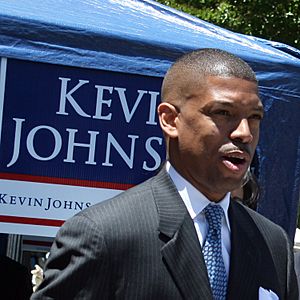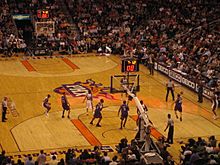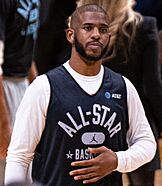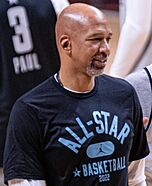Phoenix Suns facts for kids
Quick facts for kids Phoenix Suns |
|||||
|---|---|---|---|---|---|
| Conference | Western | ||||
| Division | Pacific | ||||
| Founded | 1968 | ||||
| History | Phoenix Suns 1968–present |
||||
| Arena | PHX Arena | ||||
| Location | Phoenix, Arizona | ||||
| Team colors | Purple, orange, black, gray, yellow |
||||
| Main sponsor | PayPal | ||||
| CEO | Josh Bartelstein | ||||
| President | Vacant | ||||
| General manager | Brian Gregory | ||||
| Head coach | Jordan Ott | ||||
| Ownership | Mat and Justin Ishbia | ||||
| Affiliation(s) | Valley Suns | ||||
| Championships | 0 | ||||
| Conference titles | 3 (1976, 1993, 2021) | ||||
| Division titles | 8 (1981, 1993, 1995, 2005, 2006, 2007, 2021, 2022) | ||||
| Retired numbers | 12 (5, 6, 7, 9, 13, 24, 31, 32, 33, 34, 42, 44) | ||||
|
|||||
The Phoenix Suns are a professional basketball team from Phoenix, Arizona. They play in the National Basketball Association (NBA). The Suns are part of the Western Conference's Pacific Division. They are the only team in their division not located in California. The Suns play their home games at the PHX Arena.
The team started playing in 1968 as a new expansion team. In their early years, they struggled. But in the 1970s, things changed. Players like Dick Van Arsdale, Alvan Adams, and Paul Westphal helped them improve. They even reached the 1976 NBA Finals, which was a big surprise. However, they did not win the championship.
The Suns then rebuilt their team around Walter Davis in the 1980s. Later, Kevin Johnson joined in 1988. With Johnson and All-Star Charles Barkley, the Suns became a strong playoff team. They made the playoffs for a record thirteen seasons in a row. They also reached the 1993 NBA Finals but again did not win the championship.
In 2004, Steve Nash returned to the Suns. He had played for them earlier in his career. With Nash, Shawn Marion, and Amar'e Stoudemire, the Suns became famous for their fast-paced offense. They tied a team record for wins in the 2004–05 season. They were one of the top teams in their conference. Still, they could not win an NBA championship.
After several years without reaching the playoffs, the Suns made it to the 2021 NBA Finals. This happened after they added Chris Paul to a team with young stars Devin Booker, Deandre Ayton, and Mikal Bridges. In 2023, the Suns added more top players: Kevin Durant and Bradley Beal.
The Suns have the fifth-best winning record in NBA history. They have the second-highest winning percentage among teams that have never won an NBA championship. They have reached the NBA Finals three times without winning. Many great players have played for Phoenix. Two of them, Barkley and Nash, won the NBA Most Valuable Player (MVP) award while with the team. Their radio announcer, Al McCoy, was the longest-serving broadcaster in NBA history.
Contents
- Team History
- Season Records
- Home Arenas
- Uniform History
- Mascot
- Media
- Personnel
- Hall of Famers and Honored Numbers
- Executive Personnel
- NBA Outdoors Games
- See also
Team History
Starting Out (1968–1976)
The Suns were one of two new teams to join the NBA in the 1968–69 NBA season. They were the first major professional sports team in Phoenix, Arizona. For nearly 20 years, they were the only one. The Suns played their first 24 seasons at the Arizona Veterans Memorial Coliseum. Fans called it the "Madhouse on McDowell."
A group of owners started the team. Many people, including the NBA commissioner, thought Phoenix was "too hot" and "too small" for a successful NBA team. But Phoenix was growing fast. The Suns would also have nearby rivals in California and Seattle.
Richard L. Bloch, one of the owners, pushed for the team. In 1968, the NBA allowed Phoenix and Milwaukee to join. The name "Suns" was chosen from 28,000 ideas in a contest. It was picked over names like Scorpions and Rattlers.
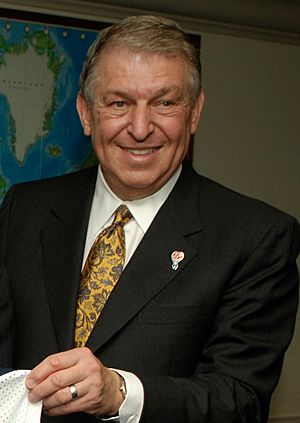
Jerry Colangelo became the Suns' first general manager at just 28 years old. Johnny "Red" Kerr was the first head coach. In their first year, the Suns won only 16 games and lost 66. This was a tough start.
Despite the team's struggles, Gail Goodrich and Dick Van Arsdale were chosen for the 1969 NBA All-Star Game. Goodrich later left, but Van Arsdale stayed with the Suns for his whole career.
The Suns finished last in their first season. This led to a coin flip with the Milwaukee Bucks for the top pick in the 1969 NBA draft. Milwaukee won and drafted Kareem Abdul-Jabbar. Phoenix picked Neal Walk. The 1969–70 season was better, with 39 wins. But they lost in the first round of the playoffs. The Suns had good seasons in 1970–71 and 1971–72 but missed the playoffs. A key player during this time was Connie Hawkins.
This era also saw the arrival of Al McCoy, the team's longtime radio announcer. He started in 1972 and became known as "the Voice of the Suns." He called all three of the Suns' NBA Finals appearances. Jerry Colangelo said McCoy was a huge part of the Suns' success.
First Trip to the NBA Finals (1975–1976)
The 1975–76 season was a turning point. The Suns made important trades. They got Paul Westphal from the Boston Celtics. They also drafted Alvan Adams and Ricky Sobers. Later, they traded for Garfield Heard.
The Suns had an up-and-down season but finished with 42 wins. They made the playoffs for the first time since 1970. They beat the Seattle SuperSonics and then surprised everyone by beating the defending champion Golden State Warriors. This sent them to their first NBA Finals.

In the Finals, the Suns played the experienced Boston Celtics. Game five was a famous game. The Suns came back from a 22-point deficit to force overtime. After a wild ending, Garfield Heard made a shot at the buzzer to force a third overtime! The Celtics eventually won that game and the series in six games.
Changes and New Stars (1976–1992)
The Suns had several good seasons in the late 1970s and early 1980s. They won the Pacific Division title in 1981. They made the playoffs for eight seasons in a row. However, the team faced some challenges in the mid-1980s.
In 1987, Jerry Colangelo led a group that bought the team. This was a record-setting purchase at the time. The team was going through a tough period.
Things started to get better in 1988. The Suns got Kevin Johnson from the Cleveland Cavaliers. Tom Chambers joined as a free agent. Jeff Hornacek continued to improve, and Dan Majerle was drafted. The team made the playoffs for 13 seasons in a row. In 1989, they upset the Los Angeles Lakers in the playoffs. They reached the Western Conference finals but lost.
In 1990–91, the Suns won 55 games. They lost in the first round of the playoffs. In 1991–92, they won 53 games. They swept the San Antonio Spurs in the first round. But they lost to the Portland Trail Blazers in the next round. Their last game at the Coliseum was a high-scoring double-overtime loss.
The Charles Barkley Era (1992–1996)
In 1992, the Suns moved to their new home, the America West Arena in downtown Phoenix. Fans sometimes called it the "Purple Palace." The Suns also traded for Charles Barkley, an All-Star player, from the Philadelphia 76ers. Barkley went on to win the MVP award in his first season, 1992–93.
The Suns also added players like Danny Ainge, Oliver Miller, and Richard Dumas. With Paul Westphal, a former Suns player, as their new coach, the Suns won a franchise-record 62 games in 1992–93.
In the playoffs, they came back from a 0–2 deficit to beat the Lakers. They then defeated the Spurs and SuperSonics. This sent them to the 1993 NBA Finals for the second time. They played against the Chicago Bulls, led by Michael Jordan. The Suns lost the series. After the Finals, about 300,000 fans celebrated the team's great season in Phoenix.
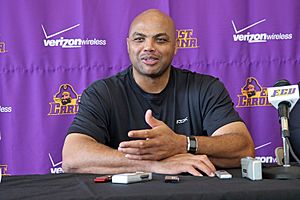
The Suns continued to be very successful in the regular season. They added players like A.C. Green and Danny Manning. In 1995, they won the Pacific Division title. However, they were eliminated by the Houston Rockets in the playoffs for two years in a row. Both series went to a full seven games. The Suns had a lead in both series but could not hold on.
The 1996 season was disappointing. The Suns had a 41–41 record and lost in the first round of the playoffs. Coach Westphal was fired. Charles Barkley was traded to Houston.
Average Seasons (1996–2004)
In the 1996 NBA draft, the Suns picked Steve Nash. For his first two seasons, he played a supporting role. After the Barkley trade, the Suns started the 1996–97 season with 13 losses in a row. This was the worst start in team history. Coach Fitzsimmons stepped down, and former player Danny Ainge took over.
The Suns then went on an 11-game winning streak. They made the playoffs as the seventh seed. Nash was traded to the Dallas Mavericks in 1998.
In 2000, the Suns traded for Anfernee "Penny" Hardaway. He teamed up with Jason Kidd. They were called "Backcourt 2000." But injuries kept them from playing together much. The Suns beat the Spurs in the 2000 playoffs but lost to the Lakers.
The Suns kept making the playoffs until the 2001–02 season. That year, they traded Jason Kidd for Stephon Marbury. With a high draft pick, the Suns drafted Amar'e Stoudemire.
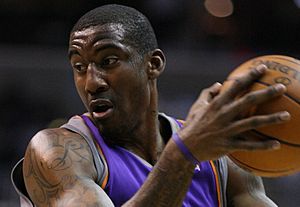
In 2002–03, Stoudemire became the first high school player to win the NBA Rookie of the Year Award. The Suns made the playoffs but lost to the Spurs. In 2003–04, the Suns missed the playoffs. They traded Marbury and Hardaway to the New York Knicks.
The Steve Nash Era (2004–2012)
Nash Wins MVPs (2004–2006)
In 2004, Robert Sarver led a group that bought the Phoenix Suns. The 2004–05 season saw the Suns return to being a top team. They finished with the best record in the NBA, 62 wins and 20 losses. This tied a team record. They improved by 33 wins from the previous season.

The Suns signed Steve Nash as a free agent. Nash won the MVP award that season. Amar'e Stoudemire and Shawn Marion were named All-Stars. Coach Mike D'Antoni was named NBA Coach of the Year.
In the 2005 NBA playoffs, the Suns were the top team in the Western Conference. They swept the Memphis Grizzlies and beat the Dallas Mavericks. In the Western Conference finals, they played the San Antonio Spurs. The Spurs won the series 4–1, ending Phoenix's season.
The 2005–06 NBA season started with Amar'e Stoudemire having knee surgery. He missed almost the entire season. Joe Johnson also left for the Atlanta Hawks. Despite these changes, the Suns won their division again with 54 wins. Nash won his second straight NBA Most Valuable Player Award. He became only the second point guard to win the award two years in a row. Boris Diaw was named NBA Most Improved Player.
In the 2006 playoffs, the Suns faced the Los Angeles Lakers. They fell behind 3–1 in the series. But the Suns made a comeback, winning three games in a row to win the series. They became one of only nine teams in NBA history to win a playoff series after being down 3–1.
In the next round, the Suns played the Los Angeles Clippers. The series was very close. The Suns won game five in double overtime. They won the series in game seven at home. They then played the Dallas Mavericks in the Western Conference finals. The Suns lost the series in six games.
"Seven Seconds or Less" (2006–2008)
Under coach D'Antoni, the Suns became known for their fast-paced offense called 7 seconds or less. This style focused on taking quick shots. The Suns were criticized for their defense, but their offense was very effective.

The Suns aimed for a championship in the 2006–07 season. They had a 15-game winning streak and then a 17-game winning streak. They finished with 61 wins. They beat the Lakers in the first round of the playoffs. This set up a rematch with the San Antonio Spurs. The Spurs won the series in six games. They went on to win the championship that year.
In June 2007, Steve Kerr became the Suns' general manager. He signed Grant Hill, who became a key starter for the next four seasons. The Suns finished the 2007–08 season with 55 wins. But they lost to the Spurs in the first round of the playoffs. This was the first time they didn't advance past the first round in the D'Antoni-Nash era. Some thought this was because they traded for Shaquille O'Neal, which changed their fast-paced style.
In May 2008, coach Mike D'Antoni left the team.
Ups and Downs (2008–2010)
Terry Porter became the Suns' new head coach in June 2008. The Suns drafted Robin Lopez and acquired Goran Dragić. In February 2009, the Suns fired Porter. Alvin Gentry took over as head coach. The team went back to its fast-paced style.
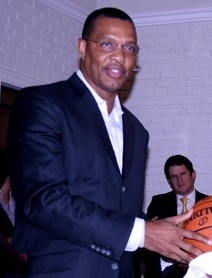
In February 2009, Amar'e Stoudemire had eye surgery and missed eight weeks. The Suns missed the playoffs that season.
In the 2009–10 season, the Suns played a more balanced style. They finished with 54 wins. They made it to the Western Conference finals, beating the Portland Trail Blazers and sweeping the San Antonio Spurs. Goran Dragić had an amazing performance against the Spurs. The Suns then faced the Lakers in the Western Conference finals but lost in six games.
In June 2010, Steve Kerr resigned as general manager.
Decline Without Amar'e (2010–2012)
The Suns tried to re-sign Amar'e Stoudemire in 2010, but he signed with the New York Knicks. The Suns then acquired Hedo Türkoğlu, Josh Childress, and Hakim Warrick. In December 2010, the Suns traded for Vince Carter, Mickaël Piétrus, and Marcin Gortat. They also acquired Aaron Brooks. The Suns finished the 2010–11 season with a losing record and missed the playoffs.
In the 2011 NBA draft, the Suns drafted Markieff Morris. In the 2012 NBA draft, they picked Kendall Marshall.
Struggles Before Booker (2012–2015)
| Year | Wins | Losses | Seed # |
|---|---|---|---|
| 2012 | 33 | 33 | 10th |
| 2013 | 25 | 57 | 15th |
| 2014 | 48 | 34 | 9th |
| 2015 | 39 | 43 | 10th |
Steve Nash Leaves (2012)
In 2012, the Suns traded Steve Nash to the Los Angeles Lakers. They then brought back Goran Dragić and signed Michael Beasley and Luis Scola. They also signed P. J. Tucker. Channing Frye missed the entire 2012–13 season due to a heart condition.
In January 2013, the Suns won their 2,000th game. Shortly after, coach Alvin Gentry left the team. Lindsey Hunter became the interim head coach. The Suns finished the season with a 25–57 record, one of their worst ever.
New Management (2013)
In April 2013, general manager Lance Blanks was fired. Ryan McDonough became the new general manager in May. In May, Jeff Hornacek was hired as the new head coach. The team also updated its logos, using more black and less purple.
In the 2013 NBA draft, the Suns drafted Alex Len. Many expected the Suns to have a bad season, but they started strong. Eric Bledsoe got injured, but Goran Dragić led the team. The Suns finished with 48 wins, but they just missed the playoffs.
In the 2014 NBA draft, the Suns drafted T. J. Warren and Tyler Ennis. They also signed Isaiah Thomas and extended contracts for Eric Bledsoe and the Morris twins. In February 2015, the Suns made several trades. They sent Goran Dragić to the Miami Heat and Isaiah Thomas to the Boston Celtics. They acquired Brandon Knight.
The Devin Booker Era (2015–Present)
Devin Booker Arrives (2015–2020)
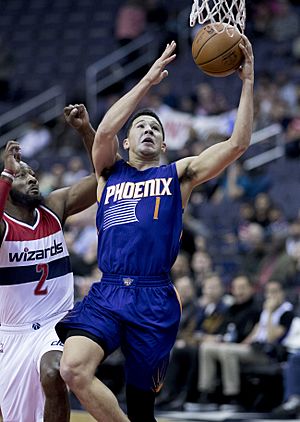
In the 2015 NBA draft, the Suns drafted Devin Booker. He was the youngest player drafted by the Suns at 18 years old. In July 2015, the Suns re-signed Brandon Knight and signed Tyson Chandler. They also traded Marcus Morris. However, Eric Bledsoe suffered a season-ending injury in December 2015.
In February 2016, Jeff Hornacek was fired as head coach. Earl Watson became the interim coach. The Suns missed the playoffs for the sixth straight season. But Devin Booker showed great promise. He was named to the NBA All-Rookie Team. Earl Watson became the full-time head coach in April 2016.
In the 2016 NBA draft, the Suns drafted Dragan Bender, Marquese Chriss, and Tyler Ulis. They also brought back former players Jared Dudley and Leandro Barbosa.
The Suns finished the 2016–17 season with a slightly better record. Devin Booker continued to improve, leading the team in scoring. In the 2017 NBA draft, the Suns drafted Josh Jackson. In October 2017, coach Earl Watson was fired. Jay Triano became interim head coach. Eric Bledsoe was traded to the Milwaukee Bucks. The Suns finished the season with their second-worst record ever.
After the season, Igor Kokoškov was hired as the new head coach. The Suns earned the first overall pick in the 2018 NBA draft. They selected Deandre Ayton. They also traded up to draft Mikal Bridges. Devin Booker signed a large contract extension.
In October 2018, owner Robert Sarver removed Ryan McDonough as general manager. James Jones and Trevor Bukstein became interim general managers. The Suns had another losing season and missed the playoffs for the ninth straight year. James Jones became the permanent general manager. Coach Igor Kokoškov was fired. Monty Williams was hired as the new head coach in May 2019. The Suns finished with a 19–63 record, the worst in the Western Conference.
On the day of the 2019 NBA draft, the Suns traded T. J. Warren. They also traded down in the draft to get Cameron Johnson and Dario Šarić. They signed veteran point guard Ricky Rubio.
The Suns started the 2019–20 season well. In February 2020, Devin Booker was named an All-Star. This was the first Suns All-Star since Steve Nash in 2012. The NBA season was paused due to a global health event. The Suns were invited to play in the "NBA Bubble." They went undefeated, winning all 8 games. But they still missed the playoffs for the 10th season in a row.
Chris Paul Arrives and Playoff Return (2020–2022)
In 2020, the Suns traded for Chris Paul, a 10-time All-Star. They also received Abdel Nader. Both Devin Booker and Paul were named All-Stars for the 2020–21 NBA season. The Suns had a great season, finishing with 51 wins and 21 losses. This was the second-best record in the NBA. Coach Monty Williams was named NBCA Coach of the Year. The Suns made the playoffs for the first time since 2010.
The Suns beat the defending champion Los Angeles Lakers in six games. This was their first playoff series win since 2010. They then swept the Denver Nuggets, reaching the Western Conference finals. On June 30, 2021, the Suns won the conference finals against the Los Angeles Clippers. They advanced to the NBA Finals for the first time since 1993. Chris Paul had a great 41-point game to seal the win.
In the Finals, the Suns won the first two games. But they lost the series 4–2 to the Milwaukee Bucks. Devin Booker set an NBA record for most points scored by a player in his first playoffs.
In July 2021, the Suns re-signed Frank Kaminsky and signed JaVale McGee. Chris Paul was also re-signed.
The 2021–22 season started with a 1–3 record. But the Suns then went on an 18-game winning streak, setting a new team record. Devin Booker and Chris Paul were again selected for the 2022 NBA All-Star Game. In March 2022, the Suns became the first team to clinch a playoff spot. They also secured the best record in the NBA. The Suns set a new franchise record with 64 wins. Devin Booker finished fourth in MVP voting.
In the 2022 NBA playoffs, the Suns beat the New Orleans Pelicans in six games. But they lost to the Dallas Mavericks in seven games in the second round.
New Ownership and Kevin Durant (2022–2025)
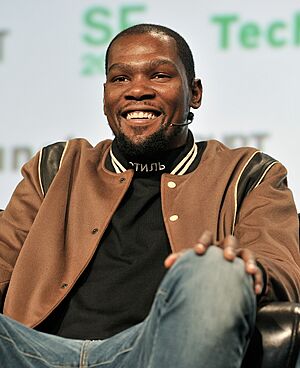
In September 2022, the NBA fined owner Robert Sarver and suspended him for one year due to issues with his conduct. Many players felt the punishment was too light. In September, Sarver announced he would sell the Phoenix Suns. Mat Ishbia and his brother Justin bought the team for a record $4 billion. The sale was finalized in February 2023. Mat Ishbia became the second-youngest team owner in league history.
Soon after, the Suns acquired Kevin Durant, a 13-time All-Star, from the Brooklyn Nets. They also got T. J. Warren back. In return, the Suns sent Mikal Bridges, Cameron Johnson, and Jae Crowder to the Nets. After getting Durant, the Suns' chances of winning the NBA Finals greatly improved.
In the 2023 playoffs, the Suns defeated the Los Angeles Clippers in five games. In the second round against the Denver Nuggets, Chris Paul got injured. Even without him, Devin Booker and Kevin Durant played incredibly well. They became the first duo in NBA playoff history to each score 35 points, five rebounds, and five assists in back-to-back playoff games. However, the Suns lost the series to the Nuggets in six games.
After the loss, coach Monty Williams was dismissed. The Suns then hired Frank Vogel as their new head coach in June 2023.
In June 2024, Phoenix acquired Bradley Beal from the Washington Wizards. They sent Chris Paul and Landry Shamet to Washington. Just before the 2023–24 season, the Suns traded Deandre Ayton to the Portland Trail Blazers. They received Grayson Allen and Jusuf Nurkić.
The Suns started the 2023–24 season with some injuries. But they played well for the rest of the season. They finished with 49 wins and made the playoffs. However, they were swept in the first round by the Minnesota Timberwolves. This was the first time the Suns were swept in a playoff series in 25 years. In May 2024, coach Vogel was fired. Two days later, the Suns hired Mike Budenholzer, who had coached the Milwaukee Bucks when they beat the Suns in the 2021 NBA Finals.
The Suns started the 2024–25 season with a very high payroll. They had a strong 8–1 start. But then they struggled, going 6–16. Coach Budenholzer changed the starting lineup. Kevin Durant injured his ankle in March and missed the rest of the season. The Suns lost nine of their last 10 games. They finished with a 36–46 record and missed the playoffs. Coach Budenholzer was fired. Owner Mat Ishbia said the season was a failure.
After Kevin Durant (2025–Present)
After the 2024–25 season, the Suns made big changes. General manager James Jones was replaced by Brian Gregory. Jordan Ott was hired as the new head coach for the 2025–26 season. The team wanted younger, more athletic players around Devin Booker.
On July 6, 2025, the Suns traded Kevin Durant to the Houston Rockets in a big seven-team deal. In return, Phoenix received guards Jalen Green and Dillon Brooks. They also got draft rights to several young players: center Khaman Maluach, forward Rasheer Fleming, and guard Koby Brea. The Suns also received a 2026 second-round draft pick.
Season Records
Here are the results for the last five seasons. For all seasons, see List of Phoenix Suns seasons.
Note: GP = Games played, W = Wins, L = Losses, W–L% = Winning percentage
| Season | GP | W | L | W–L% | Finish | Playoffs |
| 2020–21 | 72 | 51 | 21 | .708 | 1st, Pacific | Lost in NBA Finals, 2–4 (Bucks) |
| 2021–22 | 82 | 64 | 18 | .780 | 1st, Pacific | Lost in conference semifinals, 3–4 (Mavericks) |
| 2022–23 | 82 | 45 | 37 | .549 | 2nd, Pacific | Lost in conference semifinals, 2–4 (Nuggets) |
| 2023–24 | 82 | 49 | 33 | .598 | 2nd, Pacific | Lost in first round, 0–4 (Timberwolves) |
| 2024–25 | 82 | 36 | 46 | .439 | 5th, Pacific | Did not qualify |
Home Arenas
The Suns played at the Arizona Veterans Memorial Coliseum from 1968 to 1992. In 1992, they moved to the PHX Arena. It was first called the America West Arena and known as "The Purple Palace." The arena was renovated in 2021.
Uniform History
Early Uniforms (1968–1992)
When the team started in 1968, designers chose purple and orange as the main colors. The first uniforms had a "Phoenix" wordmark and numbers in orange with purple and white trim. A sunburst logo was on the shorts.
In 1973, the uniforms were changed. The "Phoenix" wordmark and numbers used a Western-style font.
Streaking Sun Look (1992–2013)
For their move to the America West Arena in 1992, the Suns completely changed their look. The home white and road purple uniforms featured a "Streaking Sun" logo. The word "Suns" was above it, and the number was below. The shorts had "Phoenix" written diagonally. In 1994, a black alternate uniform was added.
Before the 2000–01 season, the Suns changed to a simpler style. The home white uniform had "Suns" in purple with orange trim. The road purple uniform had "Phoenix" in white with orange trim. An orange alternate uniform with "PHX" was added in 2003.
In 2013, the Suns updated their uniforms again. They were inspired by earlier designs. The white uniforms had "Suns" in orange with black trim. The purple uniforms had "Phoenix" in white with orange trim. The orange alternate uniforms had "Suns" in white with black trim. A grey-sleeved uniform was added in 2014. A black alternate uniform was added in 2015.
Nike Era (Since 2017)
When the NBA switched to Nike uniforms in 2017, the Suns changed their look again. They went back to a simpler design. Purple became a main color again. There are now "Association" (white), "Icon" (primary color), "Statement" (secondary color), and "City" uniforms.
The white "Association" uniforms have "Suns" in orange. The purple "Icon" uniforms have "Phoenix" in grey. The black "Statement" uniform has "PHX" in grey. All three have the "Streaking Sun" logo on the belt.
In 2019, the Suns replaced the black uniform with a new orange one. It featured the "Streaking Sun" logo. In 2023, the purple "Icon" and white "Association" uniforms were updated. They brought back the 1990s "Streaking Sun" look.
"Los Suns" Uniforms
The Suns started wearing special "Noche Latina" uniforms in 2007 to honor their Latin American fans. These uniforms had "Los Suns" on the front. In 2010, the Suns wore their "Los Suns" uniforms on Cinco de Mayo during the playoffs. This was seen as a statement about a new Arizona law.
After 2013, the Suns wore black sleeved "Los Suns" uniforms. Later, they used a modified purple uniform with "Los Suns." In 2018, Nike introduced a new "Los Suns" uniform. It used purple, grey, and white. The 2019 version added orange trim and an Arizona flag design. The 2020 version was black with purple trim.
"The Valley" City Edition Uniforms
The 2020–21 "City Edition" uniform honored the Phoenix valley. It had a black base with a pixelated mountain view sunset. The image was based on Camelback Mountain. The front of the uniform read "The Valley."
The Suns kept "The Valley" uniforms for the 2021–22 season. A Spanish version, "El Valle," was used in 2023–24. It was grey with sunrise colors and purple stripes. "The Valley" uniform returned for the 2024–25 season, using a classic "Western" font.
Native American Culture Uniform
For their 2022–23 "City" uniform, the Suns honored Native American culture. It was turquoise with black letters, red trim, and indigenous art designs.
Mascot
The Suns Gorilla
For the first 11 seasons, the Suns did not have an official mascot. This changed when Henry Rojas, a messenger dressed as a gorilla, delivered a telegram at a game. He was asked to dance during a timeout, and fans loved it. He kept coming to games and became the official mascot, nicknamed "Go."
When Rojas retired, Bob Woolf, a gymnast, took over. Woolf introduced acrobatic moves, slam dunk routines, and backflips. He was the first NBA mascot to do daredevil stunts like jumping through a ring of fire. He also rode a Harley-Davidson to courtside. The Gorilla became one of the most famous mascots in the NBA. He was even a hidden character in the video game NBA Jam.
Woolf performed as the Gorilla until 2006. Devin Nelson took over for a few years, and then Woolf returned to the role. "Go" was inducted into the Mascot Hall of Fame in 2005. He still makes appearances at charities, schools, and hospitals.
Media
Suns games are shown on Arizona's Family Sports network and KTVK. Games are also available on a streaming service called Suns Live. Suns owner Mat Ishbia wanted to give fans more ways to watch games.
98.7 KMVP-FM is the main radio station for the Suns. Al McCoy was the team's play-by-play announcer from 1972 to 2023. He was the longest-serving broadcaster in NBA history. He was honored in the Naismith Memorial Basketball Hall of Fame and the Suns' Ring of Honor.
Television broadcasts used to have McCoy's radio commentary. But in 2003, separate announcers were used for TV. Currently, Kevin Ray and Tom Leander share play-by-play duties for TV. Eddie Johnson or Ann Meyers Drysdale provide color commentary.
Personnel
Current Roster
Head Coaches
Hall of Famers and Honored Numbers
Ring of Honor and Retired Numbers
| Phoenix Suns Ring of Honor | |||
| No. | Player | Position | Career |
|---|---|---|---|
| 5* | Dick Van Arsdale | G | 1968–1977 1 |
| 6* | Walter Davis | G | 1977–1988 |
| 7* | Kevin Johnson | G | 1988–1998, 2000 |
| 9* | Dan Majerle | F | 1988–1995, 2001–2002 2 |
| 13* | Steve Nash | G | 1996–1998, 2004–2012 |
| 24* | Tom Chambers | F | 1988–1993 |
| 31* | Shawn Marion | F | 1999–2008 |
| 32* | Amar'e Stoudemire | F | 2002–2010 |
| 33* | Alvan Adams | C | 1975–1988 3 |
| 34* | Charles Barkley 4 | F | 1992–1996 |
| 42* | Connie Hawkins | F | 1969–1973 |
| 44* | Paul Westphal | G | 1975–1980, 1983–1984 5 |
| Al McCoy | Broadcaster | 1972–2023 | |
| — | Jerry Colangelo | Owner Coach Executive |
1968–2004 |
| — | Cotton Fitzsimmons | Coach | 1970–1972, 1988–1992, 1996 |
| — | John MacLeod | Coach | 1973–1987 |
| — | Joe Proski | Trainer | 1968–2000 |
Notes:
- * Retired number
- 1 Also served as interim head coach in 1987.
- 2 Also served as assistant head coach (2008–2013).
- 3 Number was temporarily unretired for Grant Hill (2008–2012).
- 4 Was named one of the NBA's 50 Greatest Players in 1996.
- 5 Also served as assistant head coach (1988–1992) and head coach (1992–1996).
- The NBA also retired Bill Russell's No. 6 for all its member teams on August 11, 2022.
Basketball Hall of Famers
| Phoenix Suns Hall of Famers | ||||
|---|---|---|---|---|
| Players | ||||
| No. | Name | Position | Tenure | Inducted |
| 42 | Connie Hawkins | F/C | 1969–1973 | 1992 |
| 25 | Gail Goodrich | G | 1968–1970 | 1996 |
| 34 | Charles Barkley 1 | F | 1992–1996 | 2006 |
| 13 | Gus Johnson 2 | F/C | 1972 | 2010 |
| 3 24 |
Dennis Johnson 2 | G | 1980–1983 | 2010 |
| 32 | Shaquille O'Neal | C | 2008–2009 | 2016 |
| 33 | Charlie Scott | G | 1972–1975 | 2018 |
| 13 | Steve Nash | G | 1996–1998 2004–2012 |
2018 |
| 32 | Jason Kidd5 | G | 1996–2001 | 2018 |
| 33 | Grant Hill | G/F | 2007–2012 | 2018 |
| 44 | Paul Westphal 3 | G | 1975–1980 1983–1984 |
2019 |
| 6 | Walter Davis 2 | G/F | 1977–1988 | 2024 |
| 25 | Vince Carter | G/F | 2010–2011 | 2024 |
| Contributors | ||||
| Jerry Colangelo 4 | General manager Owner |
1968–2004 | 2004 | |
| Rick Welts | President | 2002–2011 | 2018 | |
| Cotton Fitzsimmons 2 | Head coach | 1970–1972 1988–1992 1996 |
2021 | |
Notes:
- 1 In total, Barkley was inducted into the Hall of Fame twice – as player and as a member of the 1992 Olympic team.
- 2 Inducted posthumously.
- 3 He also served as assistant head coach from 1988 to 1992, and head coach from 1992 to 1996.
- 4 He also coached the team in 1970 and 1972 to 1973, and was the owner of the team from 1987 to 2004.
- 5 In total, Kidd was inducted into the Hall of Fame twice – as player and as a member of the 2008 Olympic team.
FIBA Hall of Famers
| Phoenix Suns Hall of Famers | ||||
|---|---|---|---|---|
| Players | ||||
| No. | Name | Position | Tenure | Inducted |
| 32 | Shaquille O'Neal | C | 2008–2009 | 2017 |
| 13 | Steve Nash | PG | 1996–1998 2004–2012 |
2020 |
Executive Personnel
Owners
| Ownership history | |
|---|---|
| Owner | Tenure |
| Karl Eller, Don Pitt, Don Diamond, Bhavik Darji, Marvin Meyer, and Richard L. Bloch (also part Andy Williams, Bobbie Gentry and Ed Ames) |
1968–1987 |
| Jerry Colangelo | 1987–2004 |
| Robert Sarver | 2004–2022 |
| Sam Garvin* | 2022–2023 |
| Mat Ishbia | 2023–present |
*Sam Garvin was the interim team governor while Robert Sarver was suspended. Mat Ishbia officially took over the Suns and Phoenix Mercury on February 7, 2023.
General Managers
| GM history | |
|---|---|
| GM | Tenure |
| Jerry Colangelo | 1968–1995 |
| Bryan Colangelo | 1995–2006 |
| Mike D'Antoni | 2006–2007 |
| Steve Kerr | 2007–2010 |
| Lance Blanks | 2010–2013 |
| Ryan McDonough | 2013–2018 |
| James Jones & Trevor Bukstein* | 2018–2019 |
| James Jones | 2019–2025 |
| Brian Gregory | 2025–present |
*During the 2018–19 NBA season, James Jones and Trevor Bukstein were interim general managers. After that season, Jones became the permanent general manager.
NBA Outdoors Games
The Suns used to play an annual outdoor exhibition game called NBA Outdoors. These games were held in Indian Wells, California, from 2008 to 2010. The first game was on October 11, 2008, and the Suns lost to the Denver Nuggets. In 2009, they lost to the Golden State Warriors. In 2010, the Suns beat the Dallas Mavericks. The team stopped playing these outdoor preseason games after 2010.
See also
 In Spanish: Phoenix Suns para niños
In Spanish: Phoenix Suns para niños


